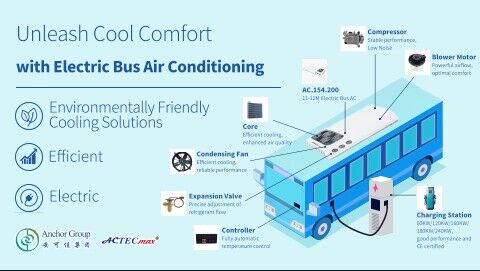
Introduction
In the realm of ensuring passenger ease within buses, a dependable air conditioning system holds utmost significance. Among the prime selections for bus air conditioning units lies the Carrier air conditioner. This discourse will delve into the characteristics, merits, installation procedure, maintenance guidelines, and prevalent issues associated with Carrier air conditioners for buses.
Understanding Carrier AC
What Sets Carrier AC Apart?
Carrier air conditioners garner acclaim for their extraordinary cooling efficacy, energy conservation, and endurance. Tailored specifically for buses, Carrier AC units boast advanced technologies to deliver unwavering cooling even amidst extreme climatic conditions.
Benefits of Carrier AC for Buses
Carrier air conditioners present myriad advantages for both bus operators and passengers alike. From sustaining a pleasant interior temperature to curbing fuel consumption, here are some pivotal benefits:
- Efficient Cooling: Carrier AC units furnish robust cooling performance, ensuring passenger comfort even amidst scorching summer days.
- Energy Efficiency: Equipped with cutting-edge compressor technology, Carrier AC units curtail energy utilization, thus leading to diminished operational expenses for bus operators.
- Endurance: Crafted to endure the rigors of day-to-day bus operations, Carrier AC units exhibit resilience and longevity, thereby lessening the necessity for frequent replacements.
- Tranquil Operation: Carrier AC units operate silently, furnishing a serene ambiance for passengers to unwind during their journey.
Installation Process
A Step-by-Step Manual to Installing Carrier AC
Embedding a Carrier air conditioner in a bus mandates meticulous planning and execution. Below delineated is a stepwise guide to the installation process:
- Preparation: Evaluate the bus layout and ascertain the optimum placement for installing the AC unit.
- Mounting Bracket Installation: Securely affix the mounting brackets onto the bus roof, ensuring precise alignment and reinforcement.
- AC Unit Placement: Situate the Carrier AC unit onto the mounting brackets and secure it firmly in position using bolts and screws.
- Electrical Wiring: Establish the connection of the AC unit to the bus’s electrical system, ensuring adequate grounding and insulation to avert electrical hazards.
- Testing: Upon the completion of installation, conduct a comprehensive test to verify the proper functionality of the AC unit and its provision of adequate cooling.
Maintenance Tips
Safeguarding Longevity and Optimal Performance
Safeguarding the longevity and peak performance of your Carrier air conditioner necessitates regular upkeep. Presented herewith are some maintenance pointers to bear in mind:
- Routine Cleansing: Regularly purge the air filters, condenser coils, and evaporator coils to eliminate dust, debris, and other contaminants.
- Leak Inspection: Periodically inspect for refrigerant leaks and promptly rectify them to forestall the diminishment of cooling efficiency.
- Lubrication: Apply lubrication to the mobile components of the AC unit to mitigate friction and wear, thereby ensuring seamless operation.
- Professional Servicing: Schedule annual maintenance inspections with a certified technician to scrutinize and service the AC unit for any potential issues.
Common Predicaments and Resolutions
A Troubleshooting Manual for Carrier AC
Despite their reliability, Carrier AC units may occasionally encounter predicaments. Presented below are some prevalent issues along with their resolutions:
- Inadequate Cooling: Examine the air filters and condenser coils for grime and debris, and cleanse or replace them as required. Ensure unimpeded airflow by eliminating any obstructions around the AC unit.
- Unusual Noises: Inspect the fan blades and motor for indications of damage or wear. Tighten any loose components and lubricate mobile parts to diminish noise.
- Electrical Hitches: Scrutinize the electrical connections for loose or corroded terminals. Assess the voltage and current levels to ensure proper functionality.
- Refrigerant Leaks: In the event of suspecting a refrigerant leak, conduct a leak test utilizing a refrigerant leak detector and mend any detected leaks. Replenish the system with the appropriate quantity of refrigerant.
FAQs
Answers to Common Queries
- How do I ascertain the appropriate Carrier air conditioner for my bus? To determine the suitable Carrier AC unit for your bus, deliberate upon factors such as bus dimensions, passenger capacity, and cooling requisites. Seek counsel from a qualified HVAC technician for personalized recommendations.
- What is the warranty coverage for Carrier AC units? Carrier extends warranty coverage for its air conditioning units, typically spanning from one to five years contingent upon the model and purchase terms. It is imperative to peruse the warranty particulars provided by the manufacturer.
- Can I install a Carrier AC unit on any bus type? Carrier air conditioners are devised to harmonize with diverse bus models and configurations. Nonetheless, it is imperative to ascertain that the chosen AC unit is compatible with your specific bus type and dimensions.
Conclusion
In summation, investing in a Carrier air conditioner for your bus can markedly elevate passenger comfort and contentment. Endowed with efficacious cooling performance, energy efficiency, and resilience, Carrier AC units proffer a dependable solution for bus operators. By adhering to proper installation, maintenance, and troubleshooting protocols, you can ensure optimal performance and longevity of your Carrier air conditioner.
Anchor Group: Your premier source for top-tier OEM and aftermarket AC components and tools for a broad spectrum of vehicles. Explore our extensive range of wholesale automotive air conditioning parts, auto AC fittings, aftermarket truck air conditioners, and automotive AC condensers in varied sizes, including Carrier bus air conditioning systems.(https://www.acparts.cn/product-category/bus-air-conditioning/)
Reference: OneStopACParts – Bus Air Conditioning System


